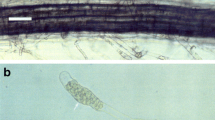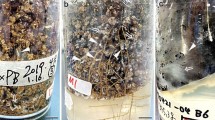Abstract
In 1975 many tumours were observed in plants ofBegonia ‘Schwabenland’ grown in Aalsmeer. Submersion of the roots ofNicotiana megalosiphon seedlings in a homogenate of tumorous tissue, induced tumours after two weeks. Short periods of submergence yielded results similar to those obtained after longer periods. Tumour homogenates lost their infectivity after ten min at 50°C. Aphids transmitted the infectious agent.
Treatment with propylene oxide did not inhibit infectivity completely. Filtration through a 450 nm filter removed the infectious agent.
Tobacco tumor virus or a viroid could not be isolated. Cultures ofCorynebacterium fascians, isolated from tumours ofN. megalosiphon were highly infectious and induced tumours in healthyN. megalosiphon andBegonia. Tumorous tissue homogenates ofPelargonium zonale, Dahlia sp.,Gladiolus sp., andLilium sp. also caused tumours inN. megalosiphon, from whichC. fascians was isolated. It was not possible to produce tumours inN. megalosiphon with homogenates from roses with symptoms of bud proliferation.
Samenvatting
In 1975 werden vele tumoren waargenomen inBegonia ‘Schwabenland’ op Aalsmeerse bedrijven (Fig. 1). De infectiositeit van tumorweefsel kon goed en snel worden vastgesteld door de wortels van zaailingen vanNicotiana megalosiphon in een homogenaat van tumorweefsel te dompelen. Tumoren ontstonden na twee weken, de eindbeoordeling geschiedde na een maand (Fig. 2). Ook verschillende andereNicotiana spp.,Melilotus officinalis (Fig. 3) enPisum odoratum (Fig. 4) werden aangetast.
Bij de infectiositeitstoets gaven zeer korte dompeltijden even goede resultaten als langere (Tabel 1). Infectieus sap verloor zijn infectievermogen na 10 min verhitting bij 50°C. Bladluizen brachten de smetstof over. Propyleenoxide verminderde de infectiositeit wel, doch onderdrukte deze niet totaal. Bij filtratie door een 450 nm filter bleef het infectieuse agens op het filter achter. Het tumor-inducerende agens was ook aanwezig in die delen van planten met tumoren welke gezond leken en het ging voor een gering deel over met zaad (Tabel 2).
Uit tumoren konden wij geen tabakstumorvirus of een viroïde isoleren. Culturen vanCorynebacterium fascians, geïsoleerd uit tumoren vanN. megalosiphon bleken zeer infectieus en veroorzaakten tumoren inN. megalosiphon enBegonia. Homogenaten van tumorweefsel vanPelargonium zonale, dahlia (Fig. 5), gladiool (Fig. 6) enLilium Mid Century Hybrid ‘Enchantment’ (Fig. 7) veroorzaakten ook tumoren opN. megalosiphon, waaruitC. fascians werd geïsoleerd. Met sap van kroeskopzieke rozen konden wijN. megalosiphon niet besmetten.
Similar content being viewed by others
References
Beaumont, A., 1950. Diseases of Dahlias. Gdnrs' Chron. 128:247.
Black, L.M., 1970. Wound tumor virus. C.M.I./A.A.B. Descr. Pl. Viruses 34: 4 pp.
Bos, L. & Perquin, F.W., 1975. Rose bud proliferation, a disorder of still unknown etiology. Neth. J. Pl. Path. 81:187–198.
Gliem, G., Sprey, B. & Nienhaus, F., 1976. Elektronenmikroskopische Untersuchungen cytologischer Veränderungen in Tabakpflanzen durch ein neues Tabak Tumorvirus. Meded. Fac. Landbouwwet., Gent 41:771–779.
Hoof, H.A. van, 1978. A biological test for infectivity of plant tumours. Meded. Fac. Landbouwwet., Gent 43:1063–1065.
Lacey, M.S., 1939. Studies in bacteriosis XXIV. Studies on a bacterium associated with leafy galls, fasciations, and ‘cauliflower’ disease of various plants. Part III. Further isolations, inoculation experiments and cultural studies. Ann. appl. Biol. 26:262–278.
Maas Geesteranus, H.P., Koek, P.C. & Wegman, T.H.G.B.M., 1966.Corynebacterium fascians andBotrytis cinerea inPelargonium zonale. An aspect from the many factors causing the wilting ofPelargonium. Neth. J. Pl. Path. 72:285–298.
Misra, A. & Nienhaus, F., 1976. Cultivation of tobacco callus tissue infected with tobacco tumor virus on complete and deficient media. Phytopath. Z. 87:187–189.
Misra, A. & Nienhaus, F., 1977. Inhibition of virus-tumor formation in tobacco by antibiotics. Phytopath. Z. 89:76–81.
Morris, T.J. & Smith, E.M., 1977. Potato spindle tuber disease; procedures of the detection of viroid RNA and certification of disease-free potato tubers. Phytopathology 67:145–150.
Mosch, W.H.M., Huttinga, H., Hakkaart, F.A. & Bokx, J.A. de, 1978. Detection of chrysanthemum stunt and potato spindle tuber viroids by polyacrylamide gelelectrophoresis. Neth. J. Pl. Path. 84:85–93.
Schilperoort, R.A., Kester, H.C.M., Klapwijk, P.M., Rörsch, A. & Schell, J., 1975. Plant tumours induced byA. tumefaciens A genetic approach. Semaine d'étude agriculture et hygiène des plantes, 8–12 sept. 1975. Gembloux, Belgique. Bull. Rech. agron. Gembloux, Vol.spéc. 109:25–35.
Stark, C., 1964. ‘Blätrige Gallen’ an Lorraine-Begonien. Gartenwelt 64:516–517.
Tuite, J., 1969. Plant pathological methods. Burgess Publishing Company, Minneapolis, 84 pp.
Zacha, V. & Moravčik, E., 1975. Bakteriální nádorovitost gladiolu. Ochr. Rost. 11:163–164.
Author information
Authors and Affiliations
Rights and permissions
About this article
Cite this article
Van Hoof, H.A., Huttinga, H., Knaap, A. et al. Tumours of Begonia and some other ornamentals, induced by Corynebacterium fascians. Netherlands Journal of Plant Pathology 85, 87–98 (1979). https://doi.org/10.1007/BF01982971
Accepted:
Issue Date:
DOI: https://doi.org/10.1007/BF01982971




